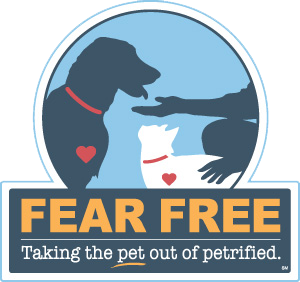How To Give Your Pet Eye Drops
Infection and injury of the eye is a common problem for many pets. Certain breeds also have a genetic predisposition to chronic eye disease. Giving an animal eye drops can be less challenging than you would think. We hope these instructions will be helpful.
Step 1: Get your cat. If you have help, one person should place your cat on a table or counter and stand behind the cat while holding the shoulders; this prevents the cat from reaching up and scratching the person doing the pilling.

Tip: If you are alone, place your cat in the corner of the sofa to stop him or her from backing away from you, or wrap him or her in a towel. The towel will also wrap up those claws.

Step 2: Place one hand beneath your pet’s jaw and gently tilt the head up.


Step 3: Hold the tube/bottle between the thumb and index finger of other hand. Rest the heel of this hand on the top of your pet’s head, just behind the eye you wish to drop the medication into.


Step 4: Now gently use the heel of your hand to pull the skin of the forehead and upper eyelid back.

Step 5: Squeeze the bottle and instill one drop into the eye. If you are using an ointment, only 1 mm is necessary.


Tip: If the ointment doesn’t drop into the eye on its own, use the edge of the upper eyelid to separate the ointment from the tip of the tube.

Step 6: Release your pet’s eye and allow him/her to blink. Blinking will move the medicine around the eye. Some eye ointments will make the eye look a bit greasy.
Repeat on the other eye if necessary.

Step 7: Reward your pet for good behaviour with gentle attention or a favourite treat.


MORE USEFULL TIPS
- It may be easier to get the medication ready before you get your pet; holding your pet and opening an eye drop vial at the same time my be a challenge.
- Never give your pet eye medication without consulting your veterinarian first. Certain ingredients in eye medications can make corneal ulcers (abrasion/defect of the surface of the eye) worse.
- Always read the instructions on the vial carefully and give all the medication as directed by your veterinarian.
- Some eye medications may make your cat drool. The taste of the eye drop travels through the tear ducts into the back of the throat. Don’t worry; the drooling will stop as soon as the bad taste goes away.
- Genetics can predispose your pet to some diseases of the eye. Cocker Spaniels & Lhasa Apsos are often victim to a disease called Keratoconjunctivitis sicca or ‘dry eye’. This disease is caused by a lack of tear production. These dogs will suffer from recurrent eye infections, chronic mucoid discharge, eye pain and eventually blindness. If diagnosed early, this condition can be successfully managed with specialized eye ointment.
- Red eyes can be a sign of a serious disease and can be caused by many different conditions:
- Bacterial infection
- Viral infection
- Allergies
- Glaucoma
- Keratoconjunctivitis Sicca
- Corneal ulcer
- Various cancers
- Pannus
- Foreign irritants
- High blood pressure
Diagnosing between these conditions requires a veterinarian’s knowledge and some specialized tests. If your pet has red eyes please make an appointment to have your pet’s eyes checked today.








